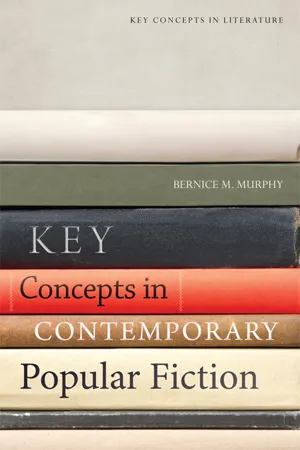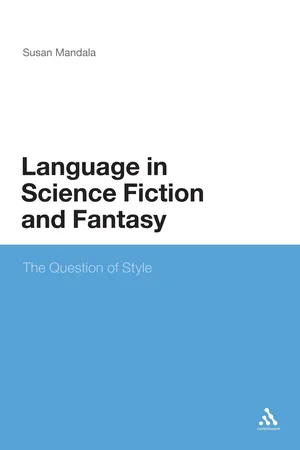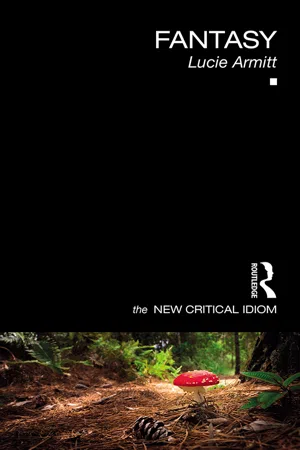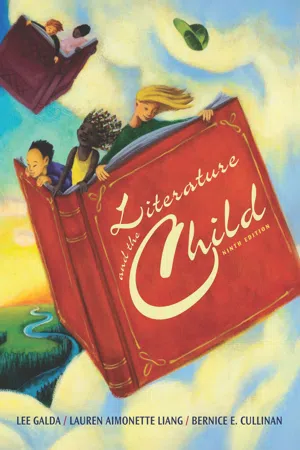Literature
Contemporary Fantasy
Contemporary fantasy is a subgenre of fantasy literature that is set in the present day or a relatively modern time period. It often involves magical or supernatural elements existing within the real world, blurring the lines between the ordinary and the extraordinary. This genre frequently explores themes of escapism, adventure, and the impact of magic on everyday life.
Written by Perlego with AI-assistance
Related key terms
1 of 5
5 Key excerpts on "Contemporary Fantasy"
- eBook - PDF
- Bernice M. Murphy(Author)
- 2017(Publication Date)
- Edinburgh University Press(Publisher)
Since 2000, fantasy children’s literature has made a major con-tribution to the current commercial prominence of the genre. As Clive Bloom notes, the work of Philip Pullman and J. K. Rowling is 116 KEY CONCEPTS IN CONTEMPORARY POPULAR FICTION pivotal in this regard (2008: 275). The genre has also benefited from the success of high-profile film and television adaptations of classic novels, such as Peter Jackson’s blockbuster The Lord of the Rings trilogy (2001–3) and the critically acclaimed television series Game of Thrones (2011–), which adapts George R. R. Martin’s A Song of Ice and Fire series (1996–). Martin’s bleak worldview and uncompromis-ing sex and violence also helped establish the ‘Grimdark’ sub-genre, which has been characterised as a reaction to the supposedly ‘sani-tised’ epic fantasy of the past. Another major fantasy trend of recent years has been the emer-gence of ‘Urban Fantasy’. Urban Fantasy in its current incarnation features savvy, street-smart protagonists (often investigators of some sort) who live in contemporary cityscapes in which the fantastical and the supernatural exist alongside everyday reality. It has proved particularly popular with female readers and authors (although there are also many prominent male authors and protagonists). Though Urban Fantasy is a relatively new publishing category, like fantasy in the broadest sense of the term, it still revolves around the relationship between ‘the magical, the strange, the weird, the wondrous’, and ‘the mundane, the world we know’ (Guran 2011: 145). Bibliography Attebury, Brian (1992), Strategies of Fantasy , Bloomington: Indiana University Press. Bloom, Clive (2008), Bestsellers: Popular Fiction since 1900 , Basingstoke: Palgrave Macmillan. Clute, John and John Grant (eds), The Encyclopaedia of Fantasy . Guran, P. (2011), ‘A Funny Thing Happened on the Way to Urban Fantasy’, in P. - eBook - PDF
The Language in Science Fiction and Fantasy
The Question of Style
- Susan Mandala(Author)
- 2010(Publication Date)
- Continuum(Publisher)
Fantasy, as Wolfe (2002: 27) points out, is now nearly all pervasive, ‘infiltrating other genres, the literary mainstream, otherwise conventional movies and TV programs, com-mercial art and advertising, music, theatre, design’ (27). Stockwell (2003a) makes the same point for science fiction, noting that it ‘informs the film and literature, the advertising and music, the street furniture and product design, food, fashion and language of global culture’ (197). The critical work on science and fiction and fantasy that has been progressing since the early 1960s has, in large part, made the re-evaluation of these genres from laughable to laudable possible by overturning many of the questionable assumptions that had accrued around them. It has been argued in several places, for example, that science fiction and fantasy are not to be dismissed as juvenile and escapist fluff. Drawing on Tolkien’s arguments (1947/1964), Hunt (in Hunt and Lenz 2001/2004: 7) and Swinfen (1984: 54, 76) both note 10 Language in Science Fiction and Fantasy that fantasy is not, in fact, easy to write, but hard: in order to create compelling and convincing other worlds, insightful observations of the world as it is are necessary. It has also been shown that neither genre can depend on the shared reader-writer context often taken for granted in realist narratives (Attebery 1992: 132). In fantasy, ‘there is no comfortable matrix of the commonplace to substitute for the imagination’ (Le Guin 1989/1993: 3), and the writer cannot ‘count on his reader’s easy familiarity with what he is talking about’ (Carter 1973: 175). Stockwell (2003b: 266) puts forward much the same case for science fiction, observing that a setting such as London in a realist novel can be sketched mostly in outline, as readers can be confidently left to fill in ‘much of the rich detail’ on their own. - eBook - PDF
Disney and the Dialectic of Desire
Fantasy as Social Practice
- Joseph Zornado(Author)
- 2017(Publication Date)
- Palgrave Macmillan(Publisher)
From ancient Greek mythology (and the Greek language where the word fantasy first emerges in the historical record) to the Judeo/ Islamic/Christian tradition of “the book,” to Sir Gawain, Chaucer, Shakespeare, the Brothers Grimm, and from Wonderland to Oz to Middle Earth, from Hogwarts to Game of Thrones, broadly conceived the meta-language of fantasy takes the form of epic mythologies. “Fantasy,” Le Guin maintains, “is at least as immense as realism and much older — essentially coeval with literature itself.” Why then was fantasy “relegated to the nursery,” as she contends, or dismissed as unwelcome offspring emerging from the nursery, as Edmund Wilson does of Tolkien’s work when he describes it as “overgrown fairy stories”? Proponents of literary fantasy like Ursula Le Guin maintain that fantasy offers access to insights to the human condition more effectively than any realism could possibly achieve. Le Guin calls writers of fantasy “the realists of a larger reality” 6 J. ZORNADO (2014), 3 while its detractors dismiss it as juvenile and unworthy. Yet, if fantasy is coeval with literature itself, as Le Guin contends, then perhaps the dismissal of fantasy by “serious” scholars should be understood as an attempt to repress that which stands for the essentially fantastical nature of reality. Fantasy is the scapegoat by which defenders of realism deny and disavow an anxiety of influence and a fear of recognition. According to the Oxford English Dictionary, the signifier “fantasy” has its roots in late Greek in the form of three variant definitions that emerged: φαντασία, a making visible; φαντάζειν, to make visible; and φαίνειν, to show. - I have commented elsewhere on the difficulties that arise from overly prescriptive attitudes towards genre identity. 1 As Andrew Rayment puts it, ‘Armitt could, perhaps, be considered a kind of spokesperson’ for those critics for whom the ‘attempt to shoehorn a text into a binding yet artificial category is a “travesty” of compartmentalization, a “death wish” of division and sub-division’ (Rayment 2014: 10). Nevertheless, close neighbours of fantasy such as science fiction, the ghost story, the horror story and the Gothic are not discussed in detail in this book, except insofar as they help to cast clearer light on what fantasy is not. Readers interested in these undoubtedly adjacent and often overlapping genres are recommended to read companion volumes in the Routledge New Critical Idiom series such as Fred Botting’s Gothic, Maggie Ann Bowers’s Magical Realism and Adam Roberts’s Science Fiction. What is fantasy? At their most conventional, at least in structural terms, fantasy narratives such as Alice in Wonderland (1865) immerse the reader into an alternative world with its own logic, landscape and temporality and subsequently return that reader intact to the frame world of realism, in this case the river-bank where Alice has been sitting with her sister. The fantasy world is not usually assumed to have collapsed when left, although Alice’s departure is certainly accompanied by chaos as the pack of courtier cards (court guards) explodes into the air ‘and came flying down upon her: she gave a little scream … and tried to beat them off, and found herself lying on the bank, with her head in the lap of her sister’ (Carroll 1929: 102). It is in this type of narrative that one experiences, most clearly, the type of ‘joyous turn’ or ‘ eucatastrophe’ which, according to Tolkien, characterizes ‘the true form of fairy-tale, and its highest function’ (Tolkien 2001: 68)
- eBook - PDF
- Lee Galda, , Lauren Liang, Bernice Cullinan, Lee Galda, Lauren Liang, Bernice Cullinan(Authors)
- 2016(Publication Date)
- Cengage Learning EMEA(Publisher)
Sometimes these stories are so steeped in ancient tales that it’s difficult to remember that they are, indeed, not folk-lore, but created by the imagination of an author. Humor, however, does not mean that a book is not deeply serious, as Kate DiCamillo and other writers have taught us. The essential element that distin-guishes “high” fantasy is “the search for meaning in life” that the story depicts, that “selective distort[ion] of reality in pursuit of truth” (Barron, 2012, p. 89). The fantastic element may be as simple as ani-mals that act like humans (or superheroes) or as complex as fully developed worlds that reflect real life with a significant twist, but they all allow read-ers to think about how the world works. Fantasy writers, playfully and seriously, use such devices as fully developed fantastic settings, nonhuman char-acters, and magic or magic realism to create fantasy. The metaphorical nature of fantasy allows young readers to consider ideas about things such as love and loss, prejudice, death, war, the consequences of beauty, heroism, pride, greed, and other serious Teaching Idea 7.2 EXPLORING GRAPHIC NOVEL SHORT STORIES This Teaching Idea addresses Common Core English Language Arts, Reading: Literature standard 9 for grades 4 through 8. The suggestions in this Teaching Idea may need to be adapted to suit your particular grade level and the needs of your students. The following are some examples of approaches you might want to pursue in using The Hidden Doors as a vehicle for discussing fantasy. ● Because each of the stories in The Hidden Doors features a door, ask small groups of students to compare and contrast how each author/artist chooses to address this element.
Index pages curate the most relevant extracts from our library of academic textbooks. They’ve been created using an in-house natural language model (NLM), each adding context and meaning to key research topics.




